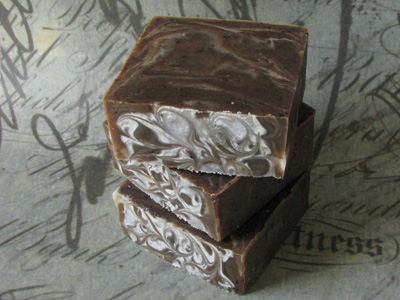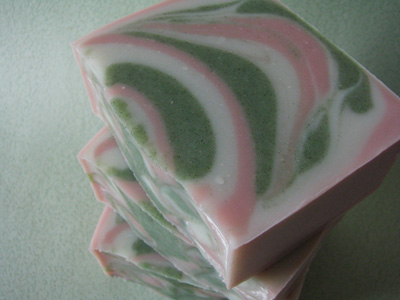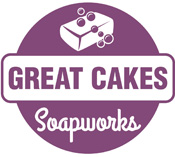Scenting Soaps Naturally
For the past couple of years I have contemplated how I can offer more naturally scented soaps – that is, using plant-derived scents instead of synthetic fragrances. Natural essential oils can provide many beneficial properties from the plants they were extracted from. Some are anti-bacterial, anti-fungal, anti-depressant, and the list goes on… (For more information about essential oils and their properties, please visit AromaWeb.)
However, there are limitations to using essential oils in handmade soaps. Natural scents are limited by what can be found in nature, and what can be distilled into an essential oil. Even though apples and raspberries can be found in nature, there’s no such thing as apple or raspberry essential oil, for example. Natural scents are usually quite a bit more expensive than their synthetic counterparts, and their scents may not hold up to what is initially a rather harsh environment when the soap is made. As the soap cures over several weeks, it becomes extremely mild, but during those first 24 hours the fresh soap is very caustic and hot. Some natural essential oils can be skin irritants, and others can cause the skin to be extra-sensitive to sun exposure, and some are unsafe during pregnancy, so not all natural ingredients are actually good for your skin!
There are several soaps in the Great Cakes Soapworks line that are currently scented synthetically, but could be scented naturally. For instance, last year I was able to create a blend of essential oils for the Oatmeal, Milk & Honey soap that doesn’t really smell like the synthetic fragrance I used to use, but is still a very nice alternative. Just this past week, I decided to see if I could re-create the Cinnamon Bun Coffee Soap with some natural essences. I have some 20-fold vanilla oleoresin that is quite thick and holds up to the soapmaking process. Combining it with a bit of cinnamon essential oil smells pretty fantastic, but doesn’t have the same WOW factor as the synthetic fragrance. Not to mention that the oleoresin alone is more than twice the price of its synthetic counterpart. Here is the result of my test batch of five bars:

I don’t think I’ll be re-creating this soap in a full-sized batch though. Even if the scent came close to what my customers are used to, unfortunately I couldn’t justify the price.
I also experimented with a couple of new soaps that are completely natural, and I believe they turned out much nicer. The first one is a test batch (5 bars) of Ginger Lime, made with ginger CO2 extract and four-fold lime essential oil and colored with algae powder:

It smells amazing!! I’m not sure how the green color will hold up over time, but I like the results so far! Depending on how my customers like it, I am hoping to create full-sized batches (24 bars) of this one.
The next soap came as a request from a customer for something scented with bergamot. She uses it in an oil diffuser at home and wanted to know if I had any soaps or could make a soap with the same scent. She reminded me that bergamot is what gives earl grey tea its flavor! I used a bergamot essential oil with reduced bergaptine, so it won’t cause photosensitivity and mixed it with a couple other “secret” essential oils. The result is what I’m calling Citrus Soother:

Citrus Soother is colored with rose clay, french green clay, and more algae powder. I made a medium-sized batch of this one, so there are 11 bars. All three of these all-natural soaps will be available for purchase at Greatcakessoapworks.com around February 11th.
Page with Comments
Comments are closed.

Where do you get your algae powder? I’ve got lots of different clays, extracts and such but I’ve never seen algae. Sound delightful 🙂 Love the gradient you got!
So glad you wrote this post, I’ve been playing around with some natural scenting and coloring lately too. Thanks for the further inspiration!
@Jennifer – It’s called chlorella powder. I got mine from My Spice Sage.
What an interesting topic Amy! Natural scents are not easy, but it’s a great challenge to tackle. That algae powder is just a gorgeous color in soap!
Ahhh! Thanks so much for sharing!
Love the algae powder soap, and the combination of lime essential oil and ginger CO2 extract sounds great! Beautiful and 100% natural soaps!!!
Citrus Soother is a great name! I also love the colors and pattern on it. The Ginger Lime is also very cool. You did a great job on the shading. Thanks for sharing – it takes a lot of time and knowledge to figure out what will work and be affordable in the natural fragrance offerings. I appreciate getting to learn from your experience. Your customers must love you, your products, and your responsiveness to their requests. Happy Soaping!
What a great post! It can be hard to get some of those scents that the customers just love in the essential oils and have a profitable business model. I think you are doing great and can’t wait to see what else you are going to come up with. =)
Yeah for you Amy! Welcome to the (not so very) dark side. I have been using EO’s exclusively since I started this soap making thing but for some reason (spice of life? ) when I buy other peoples soap I always buy those made with FO’s ! Some EO’s lesson with time but others like Anise and Peppermint seem to INCREASE with curing. A great book for mixing EO’s is “The Essential Oils Book” by Colleen K. Dot. I think you’ll love it.
Love that Citrus Soother! Bergamot is one of my favorite EOs, too. And I also have some of that vanilla oleoresin, but haven’t even tried it in soap yet. It seems too precious somehow! Crazy, huh?
Love them!!! Natural scents and colors are the only thing I use. I have a feeling the green will fade. I use Spirulina in one of mine and if it is exposed to any kind of light for any period of time, the green fades. 🙁 I’ll be experimenting with something called chlorrophyll extract (it’s sold as a supplement) which gives (supposedly) a more stable green.
I love the citrus soother. It’s lovely. What is that layering/swirling technique called? I’ve not delved into too much swirling, so I’m pretty clueless as to what the techniques are called.
@SarahD – I’ve heard it called the Tiger Stripe swirl. You can get lots of different effects depending on your colors and how thin or thick you pour. Pretty neat looking, isn’t it?
oooh I was about to place an order but I think I’ll wait for these flavors
The above soaps are so wonderful.I like it so much.their colors are natural.Also, they smell amazing.
I know this is late but i have had good luck with patchouli and cinnamon it smells just like a cinnamon coffee cake type scent.
Hi Amy! I have chlorella and spirulina powders that have been sitting around for some time because I thought I could mix them into my drink for something healthy, but I just can’t stand the taste and smell! Was wondering if the green color from the chlorella held up? I’ve read from other blogs that spirulina turns brown.
@Silvia – The chlorella faded to an olive green color when it was exposed to light. Not terribly ugly, but not bright and beautiful like it started out.
Thank you for your reply, Amy. Olive green is ok with me, I just don’t want it turning brown. I will try using chlorella some day. 🙂
What an interesting topic Amy! Natural scents are not easy, but it’s a great challenge to tackle. That algae powder is just a gorgeous color in soap